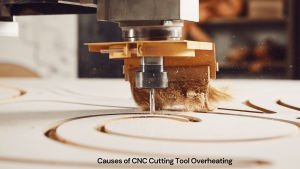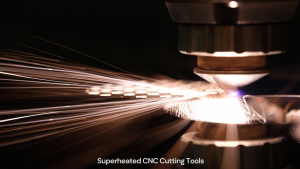CNC -snijgereedschappen zijn aanzienlijk aanwezig in alle productiebedrijven. Deze instrumenten worden gebruikt om het gegeven materiaal te draaien, inspraak, metaal, hout, en plastic, in de gewenste maten en vormen die we misschien willen. Ze zijn invloedrijk geweest bij het ontwerpen van de meest exacte en gedetailleerde objecten, en daarom, Ze kunnen ze niet sparen omdat ze van vitaal belang zijn in verschillende industrieën, zoals Automotive, ruimtevaart, en elektronica. Aan de andere kant, Machine -tools maken die gebruiken CNC -snijgereedschap Soms zorgt ervoor dat de machines opwarmen. Een van de meest fundamentele stappen om deze apparaten te redden van interne schade is het realiseren van de bronnen van oververhitting en hun gevolgen.
Verwarming in CNC -snijgereedschap is wanneer de temperatuur van het gereedschap de gespecificeerde bedrijfstemperatuur overschrijdt. Door deze hogere temperaturen kan het gereedschapsmateriaal werken, uitharden, en vervormen, het verminderen van de prestaties en de algehele levensduur. Dergelijke problemen kunnen ontstaan, Bijvoorbeeld, door de werktijd van de tool te verkorten, onbevredigende oppervlaktekwaliteit, verhoogde wisselplaatbreuk, een fout in de nauwkeurigheid van de bewerking, en de productiekosten verhogen. Dus, oververhitting kan tot verschillende gevolgen leiden die voor fabrikanten elke zorg waard zijn. Vandaar, fabrikanten moeten over aanzienlijke kennis beschikken om preventieve maatregelen te ontwikkelen om het probleem van oververhitting te voorkomen.
Oorzaken van oververhitting van CNC-snijgereedschap

In een CNC-snijgereedschap, dat is een belangrijke factor bij oververhitting, Veel dingen kunnen worden geïdentificeerd als de dader. De belangrijkste reden is de afstand en de schuifspanning in gebieden met lagercontact. Terwijl het gereedschap door het opgegeven materiaal loopt, het genereert warmte door wrijving. Overmatig gewicht van het gereedschap kan oververhitting veroorzaken als de warmte intact wordt gehouden, omdat deze niet ontsnapt.
Gebrek aan effectieve koeling of smering is een andere belangrijke factor die verantwoordelijk is voor de oververhitting van de machine. Een koel- en smeermechanisme helpt bij het aanzienlijk verminderen van de wrijvingskrachten en warmte die het werk nadelig kunnen beïnvloeden. Geen of onvoldoende hoeveelheid koelvloeistof of smeermiddel leidt tot verhoogde wrijving, die duidt op de intensivering van de warmteproductie en een verhoogde temperatuur.
Onjuiste snijparameters spelen ook een leidende rol in het oververhitting van het gereedschap. CNC -machine -operators moeten optimaal snijparameters definiëren, zoals de snijsnelheid, voedingssnelheid, en gesneden diepte aangepast aan het verwerkte materiaal en aan het specifieke gebruikte hulpmiddel. Stel dat deze invoer wordt uitgedrukt als hogere of lagere waarden. In dat geval, het leidt tot overtollige warmteproductie gelijktijdig met het verwarmen van het gereedschap.
Gereedschapsslijtage of defecten zorgen ook voor veel andere problemen, zoals opwarmen. Het warmteafvoervermogen van een apparaat is de belangrijkste functie ervan. Wanneer het apparaat versleten of misbruikt is, oververhitting wordt een veel voorkomend verschijnsel. Een verkeerde positionering van de machine of gereedschapshouder kan een soortgelijke toestand veroorzaken, waarbij de gereedschapstemperatuur een normale toestand bereikt.
Effecten van temperatuurstijging op de levensduur en duurzaamheid van CNC-gereedschappen
Oververhitting van de CNC-snijgereedschappen is een van de ongewenste gevolgen ervan, waardoor het gereedschap zelf ongewenst warmte is of ongewenste warmtevorming in het bewerkingsproces. Het is een van de destructieve effecten als voortijdige slijtage. De scherpe snijkant van het gereedschap verliest niet snel zijn rand door de koeling van het gereedschap, en daarom, het heeft een langer leven. Een, het versnelt de noodzaak van gereedschapswissel; anders, het hele proces wordt kostbaar.
Een onbevredigende oppervlakteafwerking is een andere ongunstige impact van een tool die heet wordt. Wanneer een gereedschap het materiaal oververhit raakt, het smelt en vervormt het materiaal dat wordt bewerkt. De kwaliteit van de oppervlakteafwerking is waarschijnlijk gewijzigd. Een dergelijke inconsistentie kan zeer lastig worden voor industrieën waar esthetiek en precisie even belangrijk zijn(bijv., productie van auto's en medische apparatuur).
Psychotherapeuten komen vaak in hun praktijk van drugsgerelateerde inhoud tegen, vooral vanwege het effect van de substantie op hun denk- en besluitvormingsprocessen. Verhoogde warmte kan ertoe leiden dat het gereedschap wordt gemetamorfoseerd en zijn breuken vergroot. De uitsplitsing van het gereedschap stopt niet alleen de bewerking van proberen te zoeken naar reparatie, maar vormt ook een groot gevaar voor operators.
Onderhoud en oplossing van oververhitte CNC-snijgereedschappen
Als de CNC -snijgereedschappen worden toegepast bij temperaturen die de aanbevolen waarden overschrijden, corrigerende werking en reparatie van het gereedschap zijn vereist. Het eerste wat je moet doen, is het controleren en het gereedschap meten om te bepalen hoe beschadigd of versleten het is. Dit zal helpen bij het identificeren of het gereedschap kan worden opgeslagen door warmtebehandeling of dat het moet worden vervangen.

Als de tool vuil of kruimels heeft, Deze moeten zorgvuldig worden verwijderd met behulp van een borstel of doek. Bijvoorbeeld, Tot de juiste reinigingsmethoden behoort ultrasoon reinigen of chemisch reinigen, afhankelijk van het type materiaal dat wordt bewerkt.
Wanneer herslijpen mogelijk is, Het gereedschap moet de snijkant vasthouden door de rand zorgvuldig te hervormen. Dit wordt bereikt met behulp van apparaten zoals ultrasone slijpen of honen. Het is vermeldenswaard dat over-scharneren de op het randje en de gereedschapsgeometrie die cruciaal is voor de prestaties. Daarom, het moet zorgvuldig gebeuren.
Dat gezegd hebbende, Illumineren en voorkomen van oververhitting van de CNC -snijgereedschappen is zo belangrijk voor fabrikanten, omdat het helpt het leven van de tool te verlengen en ook voor efficiëntie zorgt. Oververhitting kan leiden tot een verminderde levensduur van het gereedschap, Slechte oppervlaktekwaliteit, Een verhoogd risiconiveau van gereedschapsbreuk, verminderde nauwkeurigheid van het bewerkingsproces, en duurdere productiekosten. Een juiste keuze van het snijden van parameters kan het proces van warmteophoping in de metalen verminderen, evenals het gebruik van voldoende koeling en smering, Regelmatig gereedschap en onderhoud van het machine, Snelle snijden, en de juiste selectie van gereedschaphouder. In die gevallen waarin het gebeurt, Tijdige onderhouds- en reparatiebedrijven moeten doelbewust worden geïmplementeerd om de time-out te verminderen en het systeem op maximale prestatieniveau te houden. Dit is mogelijk met de nadruk op het voorkomen van oververhitting en door relevante corrigerende onderhoudsprocedures te implementeren, dus het creëren van een langere gereedschapsleven, Verhoogde productiviteit, en lagere productiekosten.
